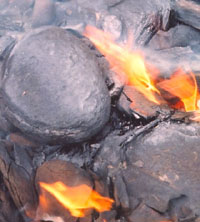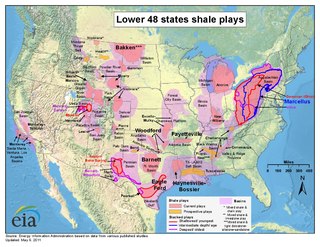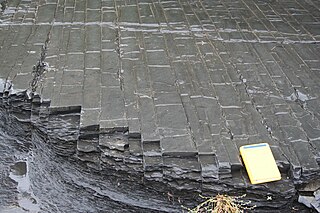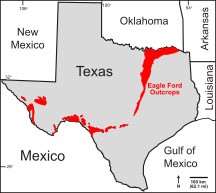Related Research Articles

Natural gas is a naturally occurring mixture of gaseous hydrocarbons consisting primarily of methane in addition to various smaller amounts of other higher alkanes. Low levels of trace gases like carbon dioxide, nitrogen, hydrogen sulfide, and helium are also usually present. Methane is colorless and odorless, and the second largest greenhouse gas contributor to global climate change after carbon dioxide. So odorizers such as mercaptan are commonly added to natural gas supplies for safety so that leaks can be readily detected.

Oil shale is an organic-rich fine-grained sedimentary rock containing kerogen from which liquid hydrocarbons can be produced. In addition to kerogen, general composition of oil shales constitutes inorganic substance and bitumens. Based on their deposition environment, oil shales are classified as marine, lacustrine and terrestrial oil shales. Oil shales differ from oil-bearing shales, shale deposits that contain petroleum that is sometimes produced from drilled wells. Examples of oil-bearing shales are the Bakken Formation, Pierre Shale, Niobrara Formation, and Eagle Ford Formation. Accordingly, shale oil produced from oil shale should not be confused with tight oil, which is also frequently called shale oil.
Petroleum geology is the study of origin, occurrence, movement, accumulation, and exploration of hydrocarbon fuels. It refers to the specific set of geological disciplines that are applied to the search for hydrocarbons.

Kerogen is solid, insoluble organic matter in sedimentary rocks. It consists of a variety of organic materials, including dead plants, algae, and other microorganisms, that have been compressed and heated by geological processes. Altogether kerogen is estimated to contain 1016 tons of carbon. This makes it the most abundant source of organic compounds on earth, exceeding the total organic content of living matter 10,000-fold.

Coalbed methane, coalbed gas, or coal seam gas (CSG) is a form of natural gas extracted from coal beds. In recent decades it has become an important source of energy in United States, Canada, Australia, and other countries.
Shale oil is an unconventional oil produced from oil shale rock fragments by pyrolysis, hydrogenation, or thermal dissolution. These processes convert the organic matter within the rock (kerogen) into synthetic oil and gas. The resulting oil can be used immediately as a fuel or upgraded to meet refinery feedstock specifications by adding hydrogen and removing impurities such as sulfur and nitrogen. The refined products can be used for the same purposes as those derived from crude oil.
In petroleum geology, source rock is rock which has generated hydrocarbons or which could generate hydrocarbons. Source rocks are one of the necessary elements of a working petroleum system. They are organic-rich sediments that may have been deposited in a variety of environments including deep water marine, lacustrine and deltaic. Oil shale can be regarded as an organic-rich but immature source rock from which little or no oil has been generated and expelled. Subsurface source rock mapping methodologies make it possible to identify likely zones of petroleum occurrence in sedimentary basins as well as shale gas plays.

Shale gas in the United States is an available source of unconventional natural gas. Led by new applications of hydraulic fracturing technology and horizontal drilling, development of new sources of shale gas has offset declines in production from conventional gas reservoirs, and has led to major increases in reserves of U.S. natural gas. Largely due to shale gas discoveries, estimated reserves of natural gas in the United States in 2008 were 35% higher than in 2006.

The New Albany Shale is an organic-rich geologic formation of Devonian and Mississippian age in the Illinois Basin of the United States. It is a major source of hydrocarbons.

The Utica Shale is a stratigraphical unit of Upper Ordovician age in the Appalachian Basin. It underlies much of the northeastern United States and adjacent parts of Canada.
Oil shale in Belarus is a large, but undeveloped energy resource. While the reserves have been known for decades, they remain unexplored due to oil shale's high ash and sulphur content, low heat of combustion and high cost of extraction and processing. However, depletion of conventional petroleum and natural gas reserves, as well as a high degree of reliance on imported hydrocarbons from Russia, have recently renewed interest in oil shale exploration in the country.
The Weald Basin is a major topographic feature of the area that is now southern England and northern France from the Triassic to the Late Cretaceous. Its uplift in the Late Cretaceous marked the formation of the Wealden Anticline. The rock strata contain hydrocarbon deposits which have yielded coal, oil and gas.
Shale gas is an unconventional natural gas produced from shale, a type of sedimentary rock. Shale gas has become an increasingly important source of natural gas in the United States over the past decade, and interest has spread to potential gas shales in Canada, Europe, Asia, and Australia. One analyst expects shale gas to supply as much as half the natural gas production in North America by 2020.

Fracking in the United Kingdom started in the late 1970s with fracturing of the conventional oil and gas fields near the North Sea. It was used in about 200 British onshore oil and gas wells from the early 1980s. The technique attracted attention after licences use were awarded for onshore shale gas exploration in 2008. The topic received considerable public debate on environmental grounds, with a 2019 high court ruling ultimately banning the process. The two remaining high-volume fracturing wells were supposed to be plugged and decommissioned in 2022.
Shale gas in the United Kingdom has attracted increasing attention since 2007, when unconventional onshore shale gas production was proposed. The first shale gas well in England was drilled in 1875. As of 2013 a number of wells had been drilled, and favourable tax treatment had been offered to shale gas producers.

The Marcellus natural gas trend is a large geographic area of prolific shale gas extraction from the Marcellus Shale or Marcellus Formation, of Devonian age, in the eastern United States. The shale play encompasses 104,000 square miles and stretches across Pennsylvania and West Virginia, and into eastern Ohio and western New York. In 2012, it was the largest source of natural gas in the United States, and production was still growing rapidly in 2013. The natural gas is trapped in low-permeability shale, and requires the well completion method of hydraulic fracturing to allow the gas to flow to the well bore. The surge in drilling activity in the Marcellus Shale since 2008 has generated both economic benefits and considerable controversy.

The Eagle Ford Group is a sedimentary rock formation deposited during the Cenomanian and Turonian ages of the Late Cretaceous over much of the modern-day state of Texas. The Eagle Ford is predominantly composed of organic matter-rich fossiliferous marine shales and marls with interbedded thin limestones. It derives its name from outcrops on the banks of the West Fork of the Trinity River near the old community of Eagle Ford, which is now a neighborhood within the city of Dallas. The Eagle Ford outcrop belt trends from the Oklahoma-Texas border southward to San Antonio, westward to the Rio Grande, Big Bend National Park, and the Quitman Mountains of West Texas. It also occurs in the subsurface of East Texas and South Texas, where it is the source rock for oil found in the Woodbine, Austin Chalk, and the Buda Limestone, and is produced unconventionally in South Texas and the "Eaglebine" play of East Texas. The Eagle Ford was one of the most actively drilled targets for unconventional oil and gas in the United States in 2010, but its output had dropped sharply by 2015. By the summer of 2016, Eagle Ford spending had dropped by two-thirds from $30 billion in 2014 to $10 billion, according to an analysis from the research firm Wood Mackenzie. This strike has been the hardest hit of any oil fields in the world. The spending was, however, expected to increase to $11.6 billion in 2017. A full recovery is not expected any time soon.
The Albert Formation is a stratigraphic unit of Early Mississippian (Tournaisian) age in the Moncton Subbasin of southeastern New Brunswick. It was deposited in a lacustrine environment and includes fossils of fish and land plants, as well as trace fossils. It also includes significant deposits of oil shale. The oil shale beds are the source rocks for the petroleum and natural gas that has been produced from Albert Formation reservoirs at the Stoney Creek and McCully fields. In addition, the solid asphalt-like hydrocarbon albertite was mined from the Albert Formation at Albert Mines between 1854 and 1884.

The West Siberian petroleum basin is the largest hydrocarbon basin in the world covering an area of about 2.2 million km², and is also the largest oil and gas producing region in Russia.

Unconventional reservoirs, or unconventional resources are accumulations where oil & gas phases are tightly bound to the rock fabric by strong capillary forces, requiring specialised measures for evaluation and extraction.
References
- ↑ Bowland Shale Formation. BGS Lexicon of Named Rock Units (Report). British Geological Survey . Retrieved 6 August 2016.
- ↑ The Carboniferous Bowland Shale gas study: geology and resource estimation (PDF) (Report). DECC. 2013. Retrieved 6 August 2016.
- ↑ The hydrocarbon prospectivity of Britain's onshore basins (PDF) (Report). DECC. 2010. Retrieved 11 September 2016.
- ↑ The Unconventional Hydrocarbon Resources of Britain's Onshore Basins - Shale Gas (PDF) (Report). 2014. Archived from the original (PDF) on 23 September 2016. Retrieved 11 September 2016.
- ↑ Parnell, John; Brolly, Connor; Spinks, Sam; Bowden, Stephen (March 2016). "Selenium enrichment in Carboniferous Shales, Britain and Ireland: Problem or opportunity for shale gas extraction?". Applied Geochemistry. 66: 82–87. Bibcode:2016ApGC...66...82P. doi: 10.1016/j.apgeochem.2015.12.008 . hdl: 2164/5310 .
- ↑ Kühne, Kjell; Bartsch, Nils; Driskell Tate, Ryan; Higson, Julia; Habet, André (12 May 2022). ""Carbon Bombs" - Mapping key fossil fuel projects". Energy Policy. 166: 112950. doi: 10.1016/j.enpol.2022.112950 . S2CID 248756651.